当前位置:首页> >肠动力研究院> >技术文章> > 技术文章
第64期:【Wageningen】丁酸在肉鸡胃肠道中释放的位点不同影响氨基酸利用率和消化过程
Butyrate presence in distinct gastrointestinal tract segments modififies differentially digestive processes and amino acid bioavailability in young broiler chickens
作者:P. C. A. Moquet,∗,1 S. A. Salami,∗ L. Onrust,† W. H. Hendriks,∗ and R. P. Kwakkel∗
∗Animal Nutrition Group, Wageningen University, PO Box 338, 6700 AH Wageningen, the Netherlands; and
†Department of Pathology, Bacteriology and Avian Diseases, Faculty of Veterinary Medicine, Ghent University,
Salisburylaan 133, B-9820 Merelbeke, Belgium
来源:2018 Poultry Science 97:167-176;http://dx.doi.org/10.3382/ps/pex279
翻译:肠动力研究院 梁琦
摘要:本试验旨在探究肉鸡不同胃肠道(GIT)部位的消化物中的丁酸对食糜停留时间、肠道形态和蛋白水解酶活性以及最终导致的蛋白质消化率差异的影响。320羽Ross308雄性肉鸡(1日龄,初生重42.1g±3.3g)被随机分配成5个处理组,试验分组如下,1)CTR组:饲喂不含丁酸的基础日粮;2)UP组:饲喂不受保护的丁酸的基础日粮,丁酸主要在嗉囊、腺胃、肌胃中释放;3)TB组:饲喂含有三丁酸甘油酯的基础日粮,丁酸主要在小肠中释放;4)FCB组:饲喂含有脂肪包被丁酸的基础日粮,丁酸主要在整个GIT中释放;5)UPTB组:喂食含有UP:TB=50:50的基础日粮;其中添加丁酸的日粮均以1g/kg丁酸根C4H7O2-为基础,而丁酸衍生物则以棕榈脂肪或二氧化硅包被。日粮中菜籽柏与精细的饲粮相结合以刺激青年肉鸡的消化能力。每组8羽,每组8个重复,试验为期24天。在试验第22,23和24天时致死并解剖部分肉鸡,同时收集各个GIT的食糜样品以及组织。结果显示,从各个处理组来看,肉鸡GIT中的丁酸浓度差异很大,这表明日粮之间的差异对比是成功的;当结肠和盲肠食糜中含有一定浓度的丁酸和(或)丙酸时,蛋氨酸的表观回肠消化率趋于增加,这可能是由于GIT发育和食糜停留时间的改变。相反,当嗉囊、腺胃和肌胃中存在一定浓度的丁酸时,异亮氨酸、亮氨酸、苯丙氨酸、组氨酸、赖氨酸的表观回肠消化率相应降低。此外,丁酸在GIT的肌胃之后释放还存在厌食效应,这可能归因于肠内分泌L-细胞分泌的作用。研究结果表明:1)在肉鸡中,丁酸对消化过程的影响取决于GIT中丁酸分子的水平;2)丁酸能够影响肉鸡的消化功能和氨基酸的生物利用度。
关键词:丁酸;肉鸡;消化率;食糜停留时间;位置效应
以下是相关图表
表1:基础日粮(CTR)的成分与营养组成以及含有UP、TB、FCB和UPTB的的基础日粮。
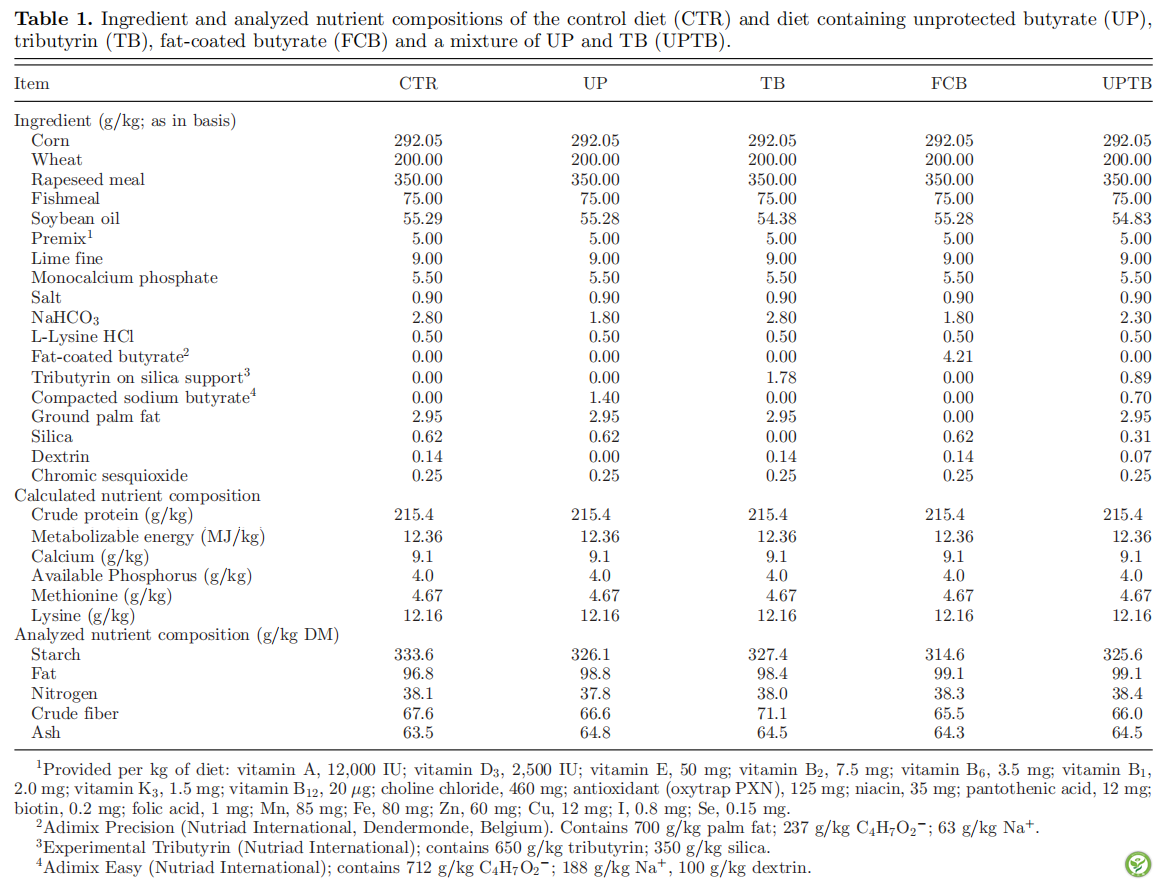
表2:Pearson相关系数(R)在SCFA浓度统计分析的对比。

表3:Pearson相关系数(R)在生产性能参数中统计分析的对比。
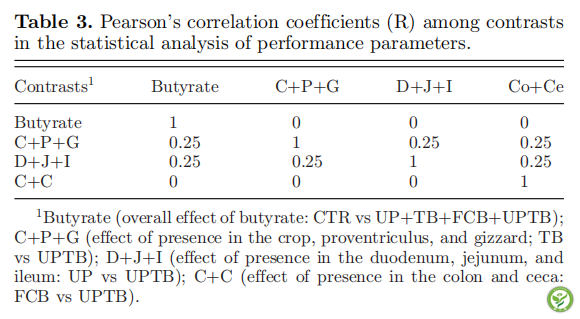
表4:日粮处理对24日龄肉鸡不同胃肠段食糜中乙酸,丙酸和丁酸浓度的影响。

表5:在0-21d,饲喂基础日粮或相同日粮添加4种丁酸制剂的肉鸡的生产性能参数的影响
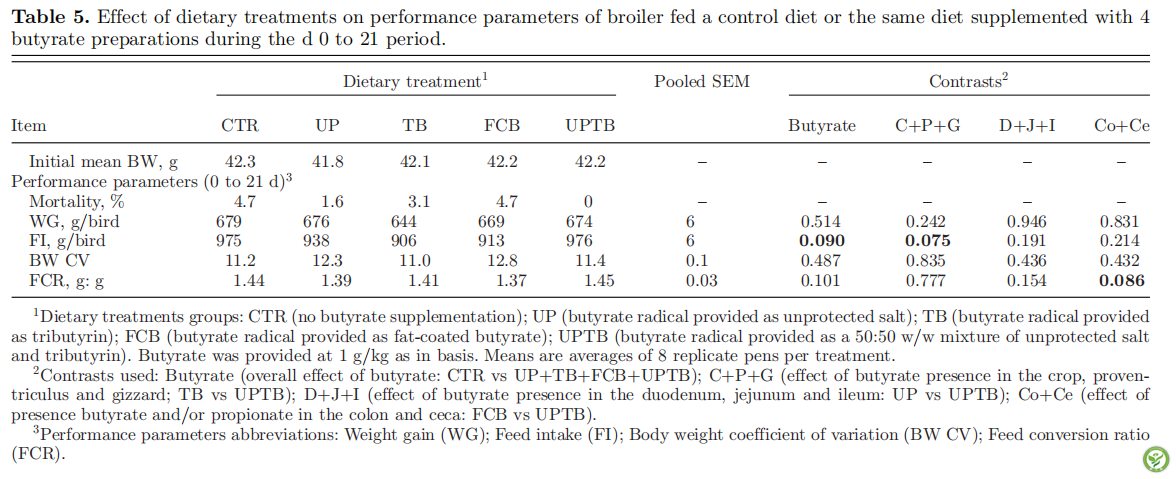
表6:在0-23d期间,喂食对照日粮或相同日粮添加有3种丁酸制剂的22至23日龄肉鸡的消化道发育,食糜停留时间,蛋白水解酶活性和肠道形态的影响。
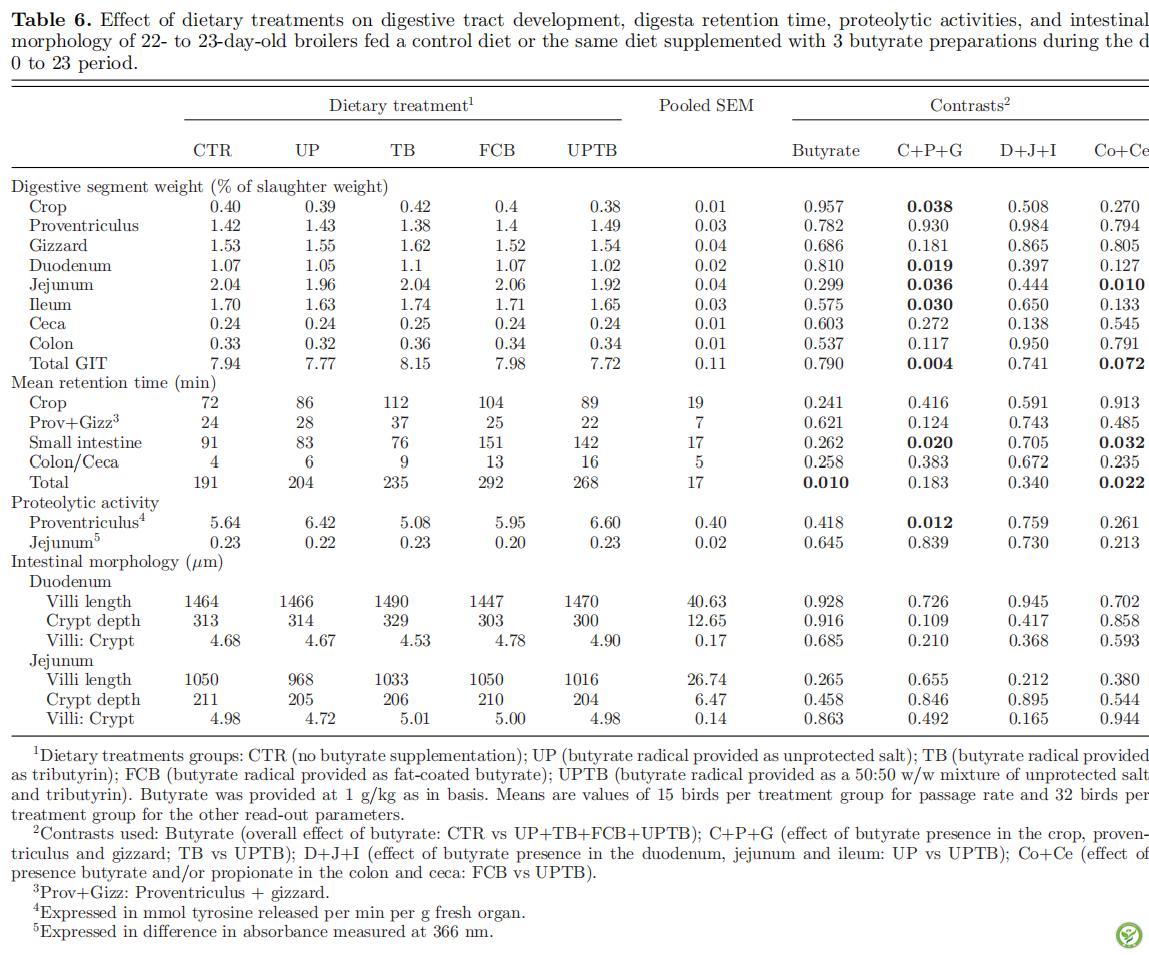
表7:在0-23d期间,饲喂对照日粮或相同日粮添加3种丁酸制剂的22-23日龄肉鸡的营养表观回肠消化率的影响。
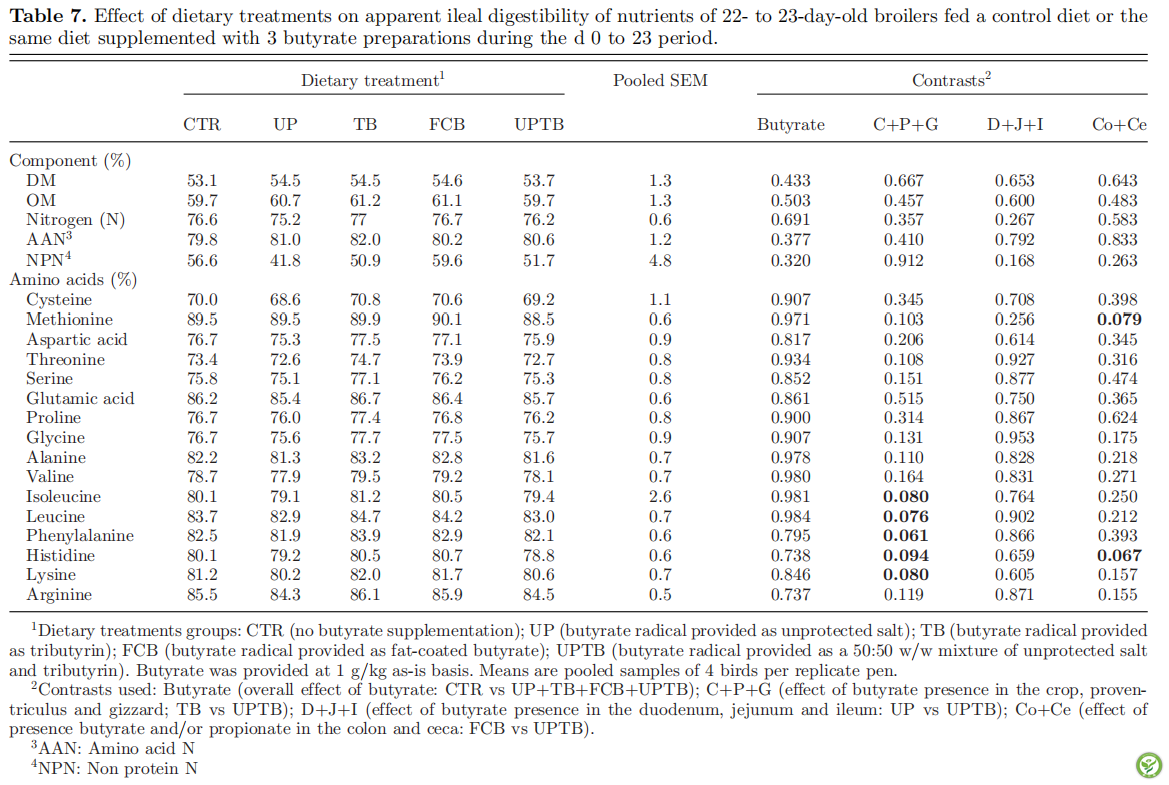
Conclusion
本研究表明,不同的丁酸衍生物在肉鸡GIT中产生的丁酸浓度差异明显。研究发现丁酸对GIT发育,蛋白水解作用或食糜停留时间的影响主要取决于GIT中丁酸分子的水平。当丁酸和/或丙酸存在于结肠和盲肠食糜中时,这种效果倾向于提高机体对蛋氨酸(家禽日粮中的第一个限制性AA)的消化率。相反,当丁酸存在嗉囊、腺胃和肌胃的食糜中时会降低几种AA(异亮氨酸,亮氨酸,苯丙氨酸,组氨酸,赖氨酸)的消化率,究其原因可能是肠道微生物活性的增加。此外,丁酸在GIT的肌胃之后释放会引起厌食效应,这可能归因于肠内分泌L-细胞活性的变化。因此,丁酸对消化功能和AA的生物利用度的影响主要取决于GIT中丁酸分子的浓度。
Abstract
The hypothesis was tested that butyrate presence in the digesta of distinct gastrointestinal tract (GIT) segments of broilers leads to differential effects on digesta retention time, gut morphology, and proteolytic enzymatic activities, ultimately resulting in differences in protein digestibility. A total of 320 male day-old Ross 308 broilers were randomly assigned to 5 dietary treatments: 1) control (no butyrate), 2) unprotected butyrate (main activity in the crop and gastric regions), 3) tributyrin (main activity in the small intestine), 4) fat-coated butyrate (activity in the whole GIT) and 5) unprotected butyrate combined with tributyrin, each replicated 8 times. Rapeseed meal was used in combination with a fine dietary particle size in order to challenge the digestive capacity of young broilers. Birds were dissected at 22, 23, and 24 d of age and samples of digesta at various GIT locations as well as tissues were collected. Butyrate concentration varied significantly across GIT segments depending on treatment, indicating that the dietary contrasts were successful. The apparent ileal digestibility of methionine tended to increase when butyrate and/or propionate was present in colonic and cecal contents, possibly due to modifications of GIT development and digesta transit time. Butyrate presence in the digesta of the crop, proventriculus and gizzard, on the contrary, decreased the apparent ileal digestibility of several amino acids (AA). In addition, butyrate presence beyond the gizzard elicited anorexic effect that might be attributable to changes in intestinal enteroendocrine L-cells secretory activities. The present study demonstrates that, in broilers, effects of butyrate on digestive processes are conditioned by the GIT segment wherein the molecule is present and indicates its influence on digestive function and bioavailability of AA.
Key words: Butyrate, broiler, digestibility, digesta retention time, location effect
Conclusion
The present study demonstrates that different butyrate derivatives can be used to create a contrast in luminal butyrate concentrations throughout the GIT of broilers. The effect of butyrate on several parameters such as GIT development, proteolytic activity or digesta retention time was found to vary depending on the GIT segment wherein the molecule was present. When butyrate and/or propionate was present in colonic and cecal contents, such effects tended to improve the digestibility of Met, the first limiting AA in practical poultry diets. In contrast, butyrate presence in the digesta of the crop, proventriculus, and gizzard decreased the digestibility of several AA, possibly due to an increase in intestinal microbiota activity. In addition, butyrate presence beyond the gizzard elicited anorexic effects that might be attributable to changes in intestinal enteroendocrine L-cells secretory activities. The effect of butyrate on digestive functions and bioavailability of AA is therefore conditioned by
the GIT segment wherein the molecule is present.